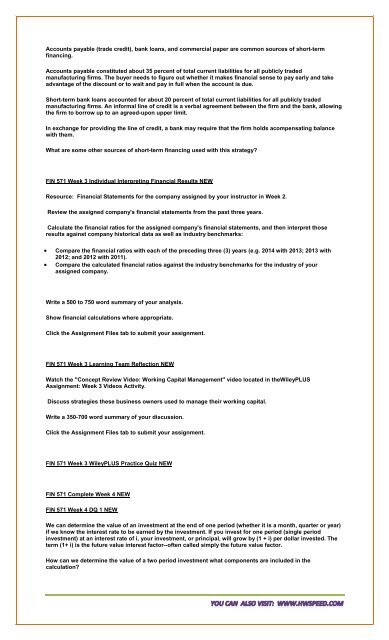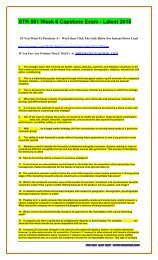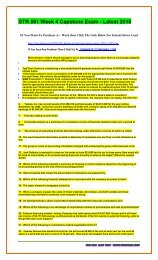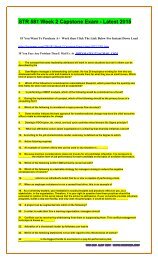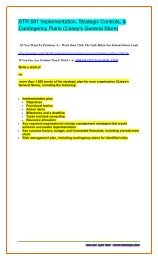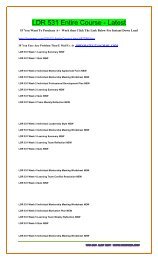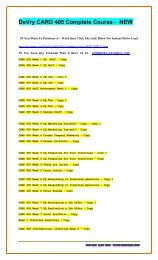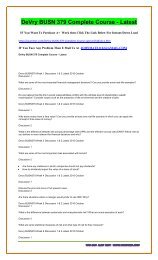FIN 571 (Foundations of Corporate Finance) Entire Course - NEW
FIN 571 (Foundations of Corporate Finance) Entire Course - NEW IF You Want To Purchase A+ Work then Click The Link Below For Instant Down Load http://psummer.com/FIN-571-Foundations-of-Corporate-Finance-Entire-Course-NEW-65434555.htm IF You Face Any Problem Then E Mail Us At JOHNMATE1122@GMAIL.COM
FIN 571 (Foundations of Corporate Finance) Entire Course - NEW IF You Want To Purchase A+ Work then Click The Link Below For Instant Down Load http://psummer.com/FIN-571-Foundations-of-Corporate-Finance-Entire-Course-NEW-65434555.htm IF You Face Any Problem Then E Mail Us At JOHNMATE1122@GMAIL.COM
Create successful ePaper yourself
Turn your PDF publications into a flip-book with our unique Google optimized e-Paper software.
Accounts payable (trade credit), bank loans, and commercial paper are common sources <strong>of</strong> short-term<br />
financing.<br />
Accounts payable constituted about 35 percent <strong>of</strong> total current liabilities for all publicly traded<br />
manufacturing firms. The buyer needs to figure out whether it makes financial sense to pay early and take<br />
advantage <strong>of</strong> the discount or to wait and pay in full when the account is due.<br />
Short-term bank loans accounted for about 20 percent <strong>of</strong> total current liabilities for all publicly traded<br />
manufacturing firms. An informal line <strong>of</strong> credit is a verbal agreement between the firm and the bank, allowing<br />
the firm to borrow up to an agreed-upon upper limit.<br />
In exchange for providing the line <strong>of</strong> credit, a bank may require that the firm holds acompensating balance<br />
with them.<br />
What are some other sources <strong>of</strong> short-term financing used with this strategy?<br />
<strong>FIN</strong> <strong>571</strong> Week 3 Individual Interpreting Financial Results <strong>NEW</strong><br />
Resource: Financial Statements for the company assigned by your instructor in Week 2.<br />
Review the assigned company's financial statements from the past three years.<br />
Calculate the financial ratios for the assigned company's financial statements, and then interpret those<br />
results against company historical data as well as industry benchmarks:<br />
<br />
<br />
Compare the financial ratios with each <strong>of</strong> the preceding three (3) years (e.g. 2014 with 2013; 2013 with<br />
2012; and 2012 with 2011).<br />
Compare the calculated financial ratios against the industry benchmarks for the industry <strong>of</strong> your<br />
assigned company.<br />
Write a 500 to 750 word summary <strong>of</strong> your analysis.<br />
Show financial calculations where appropriate.<br />
Click the Assignment Files tab to submit your assignment.<br />
<strong>FIN</strong> <strong>571</strong> Week 3 Learning Team Reflection <strong>NEW</strong><br />
Watch the "Concept Review Video: Working Capital Management" video located in theWileyPLUS<br />
Assignment: Week 3 Videos Activity.<br />
Discuss strategies these business owners used to manage their working capital.<br />
Write a 350-700 word summary <strong>of</strong> your discussion.<br />
Click the Assignment Files tab to submit your assignment.<br />
<strong>FIN</strong> <strong>571</strong> Week 3 WileyPLUS Practice Quiz <strong>NEW</strong><br />
<strong>FIN</strong> <strong>571</strong> Complete Week 4 <strong>NEW</strong><br />
<strong>FIN</strong> <strong>571</strong> Week 4 DQ 1 <strong>NEW</strong><br />
We can determine the value <strong>of</strong> an investment at the end <strong>of</strong> one period (whether it is a month, quarter or year)<br />
if we know the interest rate to be earned by the investment. If you invest for one period (single period<br />
investment) at an interest rate <strong>of</strong> i, your investment, or principal, will grow by (1 + i) per dollar invested. The<br />
term (1+ i) is the future value interest factor--<strong>of</strong>ten called simply the future value factor.<br />
How can we determine the value <strong>of</strong> a two period investment what components are included in the<br />
calculation?


